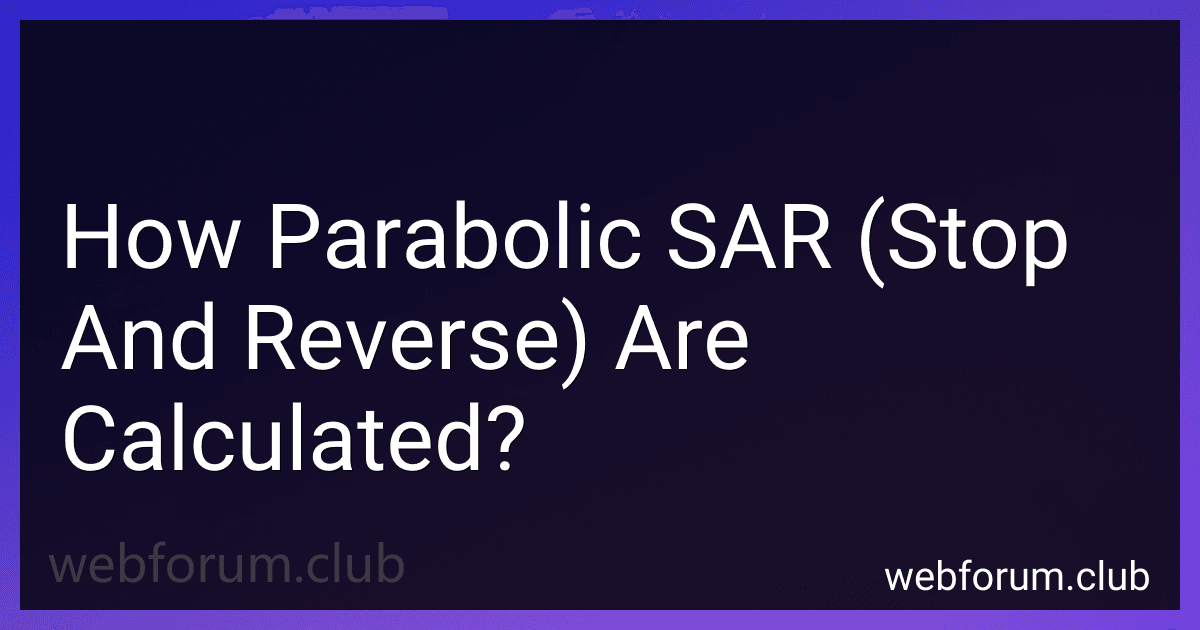Posts (page 19)
-
 7 min readThe Stochastic Oscillator is a popular technical indicator used by traders to identify overbought and oversold levels in the market. It was developed by George Lane in the late 1950s.The oscillator is based on the idea that as an asset's price increases, the closing price tends to be closer to the upper end of the price range for the given period. Conversely, as the asset's price decreases, the closing price tends to be closer to the lower end of the range.
7 min readThe Stochastic Oscillator is a popular technical indicator used by traders to identify overbought and oversold levels in the market. It was developed by George Lane in the late 1950s.The oscillator is based on the idea that as an asset's price increases, the closing price tends to be closer to the upper end of the price range for the given period. Conversely, as the asset's price decreases, the closing price tends to be closer to the lower end of the range.
-
 9 min readThe Chandelier Exit is a powerful technical analysis tool used in stock trading and other financial markets. It was developed by Charles LeBeau and popularized in his book, "Technical Traders Guide to Computer Analysis of the Futures Markets." This indicator helps traders determine their exit points by incorporating volatility into their trading strategies.
9 min readThe Chandelier Exit is a powerful technical analysis tool used in stock trading and other financial markets. It was developed by Charles LeBeau and popularized in his book, "Technical Traders Guide to Computer Analysis of the Futures Markets." This indicator helps traders determine their exit points by incorporating volatility into their trading strategies.
-
 9 min readThe Parabolic SAR (Stop and Reverse) is a technical analysis tool that helps identify potential trend reversals in the price movement of a security. It is commonly used by traders to determine when to enter or exit a trade.The Parabolic SAR is calculated using two primary variables: the acceleration factor (AF) and the extreme points (EP). The AF determines the rate at which the SAR moves closer to the price.
9 min readThe Parabolic SAR (Stop and Reverse) is a technical analysis tool that helps identify potential trend reversals in the price movement of a security. It is commonly used by traders to determine when to enter or exit a trade.The Parabolic SAR is calculated using two primary variables: the acceleration factor (AF) and the extreme points (EP). The AF determines the rate at which the SAR moves closer to the price.
-
 7 min readThe Vortex Indicator is a technical analysis tool used in the financial markets to determine the direction of the trend and identify potential reversal points. It was developed by Etienne Botes and Douglas Siepman and is based on the work of J. Welles Wilder, the creator of other popular indicators like the Relative Strength Index (RSI).The Vortex Indicator consists of two lines - the +VI (Positive Vortex Indicator) and the -VI (Negative Vortex Indicator).
7 min readThe Vortex Indicator is a technical analysis tool used in the financial markets to determine the direction of the trend and identify potential reversal points. It was developed by Etienne Botes and Douglas Siepman and is based on the work of J. Welles Wilder, the creator of other popular indicators like the Relative Strength Index (RSI).The Vortex Indicator consists of two lines - the +VI (Positive Vortex Indicator) and the -VI (Negative Vortex Indicator).
-
 9 min readThe Relative Strength Index (RSI) is a commonly used technical indicator in trading, including scalping strategies. Scalping is a trading style that aims to profit from small price movements and requires a quick entry and exit from trades. RSI is a tool that can help traders identify overbought and oversold conditions in the market.The RSI is a momentum oscillator that measures the speed and change of price movements.
9 min readThe Relative Strength Index (RSI) is a commonly used technical indicator in trading, including scalping strategies. Scalping is a trading style that aims to profit from small price movements and requires a quick entry and exit from trades. RSI is a tool that can help traders identify overbought and oversold conditions in the market.The RSI is a momentum oscillator that measures the speed and change of price movements.
-
 9 min readThe Vortex Indicator is a technical analysis tool that helps traders identify the start of a new trend and determine the strength of a current trend. It was developed by Etienne Botes and Douglas Siepman.The calculation of the Vortex Indicator involves several steps. First, the True Range (TR) is calculated, which measures the volatility of a security over a specific period. It is determined by taking the difference between the current high and low prices.
9 min readThe Vortex Indicator is a technical analysis tool that helps traders identify the start of a new trend and determine the strength of a current trend. It was developed by Etienne Botes and Douglas Siepman.The calculation of the Vortex Indicator involves several steps. First, the True Range (TR) is calculated, which measures the volatility of a security over a specific period. It is determined by taking the difference between the current high and low prices.
-
 9 min readExponential Moving Average (EMA) is a widely used technical indicator in financial markets that helps to determine the trend direction and support/resistance levels. It is a type of moving average calculation that places more weight on recent data points, making it more responsive to current price action compared to other moving averages like Simple Moving Average (SMA).EMA is calculated using a specific formula, where the most recent data points have a higher impact on the average calculation.
9 min readExponential Moving Average (EMA) is a widely used technical indicator in financial markets that helps to determine the trend direction and support/resistance levels. It is a type of moving average calculation that places more weight on recent data points, making it more responsive to current price action compared to other moving averages like Simple Moving Average (SMA).EMA is calculated using a specific formula, where the most recent data points have a higher impact on the average calculation.
-
 19 min readSome of the risks associated with day trading include:High market volatility: Day trading involves trading frequently within a single day, which exposes traders to high market volatility and price swings.Financial risk: Day trading requires a significant
19 min readSome of the risks associated with day trading include:High market volatility: Day trading involves trading frequently within a single day, which exposes traders to high market volatility and price swings.Financial risk: Day trading requires a significant
-
 17 min readTo handle exceptions in Kotlin, you can use a try-catch block. Here's an example: try { // Code that can potentially throw an exception } catch (e: Exception) { // Code to handle the exception } In the try block, you place the code that might
17 min readTo handle exceptions in Kotlin, you can use a try-catch block. Here's an example: try { // Code that can potentially throw an exception } catch (e: Exception) { // Code to handle the exception } In the try block, you place the code that might
-
 9 min readVolume Price Trend (VPT) is a technical analysis indicator that combines both price and volume data to provide insights into the strength of a price trend. It was developed by Paul Dysart in the 1980s as a means to identify the flow of money in and out of a security.The VPT indicator measures the relationship between volume and price changes. It calculates the cumulative volume moved relative to the price change over a given period.
9 min readVolume Price Trend (VPT) is a technical analysis indicator that combines both price and volume data to provide insights into the strength of a price trend. It was developed by Paul Dysart in the 1980s as a means to identify the flow of money in and out of a security.The VPT indicator measures the relationship between volume and price changes. It calculates the cumulative volume moved relative to the price change over a given period.
-
 7 min readThe Money Flow Index (MFI) is a popular momentum indicator used by traders to analyze price movements and identify potential scalping opportunities in the financial markets. It measures the flow of money into or out of an asset by taking into account both price and volume data.When interpreting the MFI for scalping purposes, traders look for overbought or oversold conditions in an asset, indicating potential reversals or trend continuations.
7 min readThe Money Flow Index (MFI) is a popular momentum indicator used by traders to analyze price movements and identify potential scalping opportunities in the financial markets. It measures the flow of money into or out of an asset by taking into account both price and volume data.When interpreting the MFI for scalping purposes, traders look for overbought or oversold conditions in an asset, indicating potential reversals or trend continuations.
-
 7 min readThe Force Index (FI) is a popular technical analysis indicator used by traders to identify strong trends and potential reversals in the market. It helps traders understand the force behind price movements and provides insights into market strength.To use the Force Index effectively as a beginner, you need to follow these steps:Calculation: The Force Index is calculated by multiplying the price change (difference between the current and previous closing price) by the volume of shares traded.
7 min readThe Force Index (FI) is a popular technical analysis indicator used by traders to identify strong trends and potential reversals in the market. It helps traders understand the force behind price movements and provides insights into market strength.To use the Force Index effectively as a beginner, you need to follow these steps:Calculation: The Force Index is calculated by multiplying the price change (difference between the current and previous closing price) by the volume of shares traded.